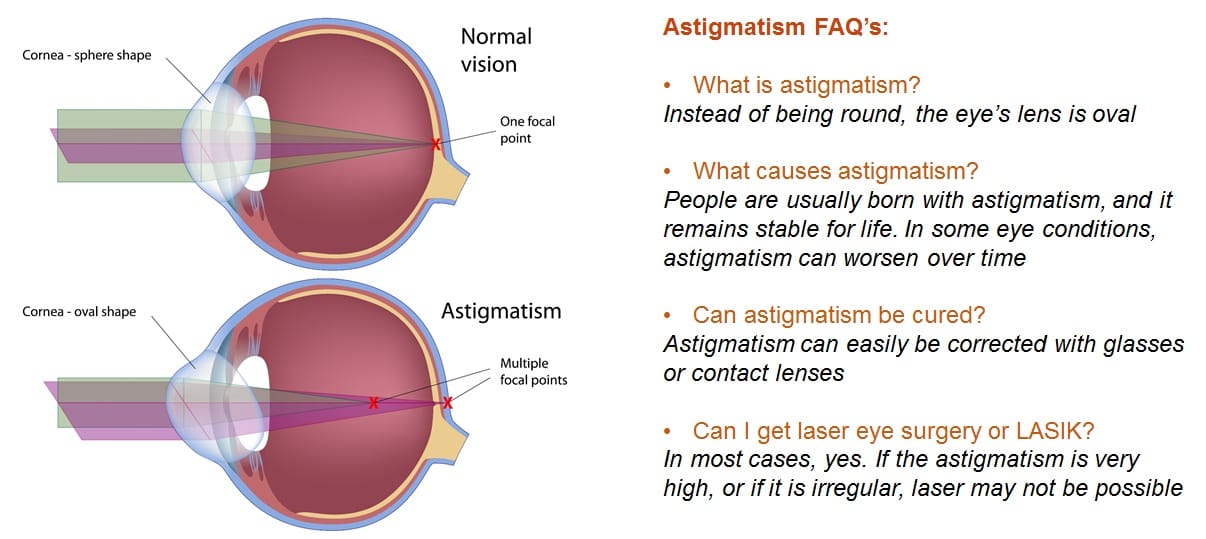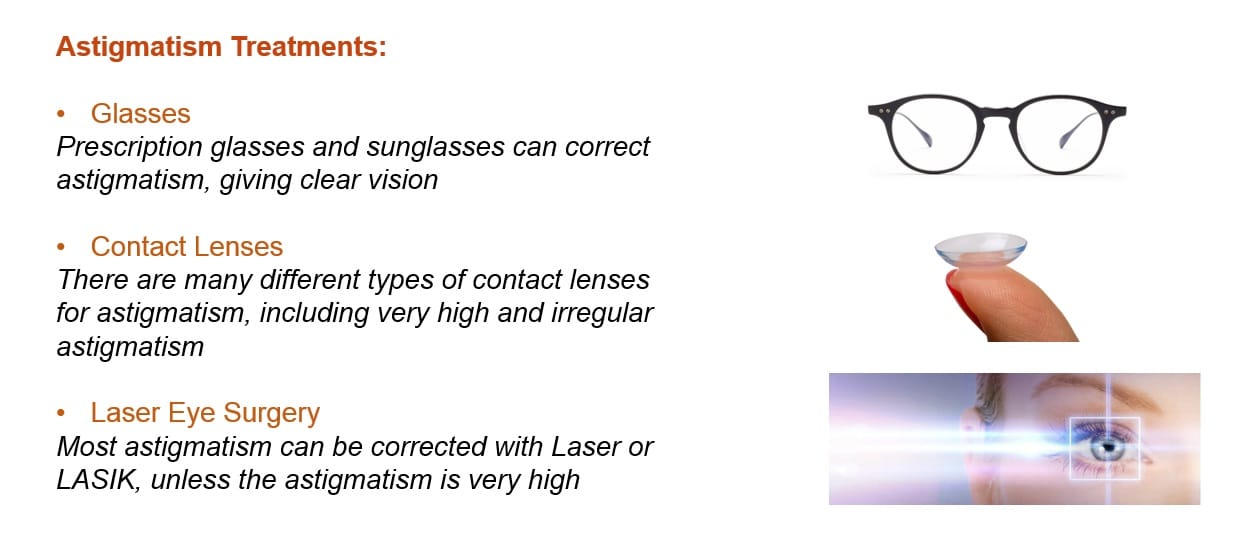Astigmatism is very common, and commonly misunderstood.
After an eye test, many people are told by their optometrist that they have “astigmatism”. This often causes confusion, and can be quite concerning – after all, astigmatism contains the word “stigma”, which doesn’t sound very nice at all!
Astigmatism is actually an extremely common eye condition, in fact the majority of people have some degree of astigmatism. Most of the time, astigmatism is nothing to worry about.
What is astigmatism?
Astigmatism is a vision condition that can cause blurred vision at any distance. Eye astigmatism is due to an imperfection in the shape of the cornea (the clear front cover of the eye, in front of the iris) or in the shape of the lens inside the eye. As a result, the light entering the eye cannot focus correctly and therefore objects appear blurred.

The cornea and lens bend the light which enters our eye, focusing it on the back of our eye so that we can see clearly. In an ideal world, the cornea would be curved perfectly, and it would be spherical in all directions. In astigmatism, the cornea is oval shaped. This causes light to be focused in two different places at the back of the eye. It can result in blurry vision when looking both far away and up close.
Astigmatism can be genetically inherited and is usually present from birth. It can be present in one or both eyes, and there can be a different amount in each eye. Some forms of irregular astigmatism, such as keratoconus, can worsen over time. Excessive eye rubbing and some forms of eye surgery can make astigmatism worse.
Eye strain, sitting too close to the TV, reading in low light and spending a lot of time on digital devices does not make astigmatism worse, however can worsen myopia or short sightedness.
Astigmatism Symptoms
Astigmatism can cause blurry vision at both far and near distances. Things may appear distorted (stretched in one direction) and it can even cause double vision. The higher the amount of astigmatism, the blurrier the vision becomes.
Astigmatism can also cause symptoms of eye strain and headaches, because the eyes are struggling to focus and see things clearly. The eyes may also squint to try and make objects clear. These symptoms could also indicate other vision problems, and it is important to have your eyes tested by an optometrist to find out exactly what is causing them.
Very low amounts of astigmatism may not cause any symptoms at all.
Astigmatism in Children
If an adult develops blurry vision, they normally notice that something is not right and this prompts them to get their eyes checked. However, if a child has a high amount of astigmatism from birth or a very young age, they may think that their vision is normal because they don’t know any different. This can make it very difficult for a parent or caregiver to realise that something is wrong until the child is much older.
Having blurry vision can severely impact on a child’s learning and their ability to achieve at school and in sports.
If it goes uncorrected, the child can develop amblyopia (a lazy eye or squint) in one or both eyes, which means that the eyes never develop to see perfectly clearly. In rare cases, children can also develop a condition called keratoconus, which is a form of irregular astigmatism that gets worse over time. Luckily, astigmatism, amblyopia and keratoconus can often be managed and treated successfully if they are diagnosed early.
This is why regular eye exams for children are so important.
Astigmatism Types
Astigmatism can happen when a person has myopia (short sightedness) or hyperopia (long sightedness). It can be regular (oval shaped) or irregular (a mixture of shapes). It can be low, moderate or high, with increasing amounts causing blurrier vision. It can occur on the cornea (clear front surface of the eye), the lens (internal lens of the eye), or a mixture of both.
Some astigmatism stays the same throughout life, and some astigmatism can get worse with age.
Astigmatism Test
An astigmatism test is performed by an optometrist or ophthalmologist. It should include measuring visual acuity (reading letters on the eye chart), auto-refraction (looking at an image in a machine), refraction (checking which lenses are required to make the vision clearer), and keratometry or corneal topography (assesses the amount, shape and type of astigmatism on the cornea).
The optometrist or ophthalmologist will then discuss the astigmatism treatment options available, including whether or not laser eye surgery for astigmatism is a good option.
Astigmatism Cure
Low amounts of astigmatism usually don’t require any treatment. Larger amounts may be optically corrected with contact lenses, glasses and in some cases laser surgery. Irregular astigmatism, such as keratoconus, can be treated with specialty contact lenses and collagen cross linking (CXL), which aims to slow down or stop the astigmatism from getting worse.
The friendly Optometrists at The Eye Practice have the expertise and cutting edge technology to advise you on the various ways astigmatism can be corrected and will help you to decide which option is best for you.
There are many myths floating around on the internet about “natural” astigmatism cures; these often involve eye exercises, eye drops, vitamins. Unfortunately, these don’t work and the ingredients in the drops or pills may be harmful.

Glasses for Astigmatism
Most astigmatism can be corrected with a pair of prescription eye glasses or prescription sunglasses. The prescription required is determined by an Optometrist in an eye examination. Astigmatism causes the eye to be oval shaped rather than round.
This means that the eye’s cornea or lens is more curved in one direction, and less curved in the opposite direction.
Optically, the more curved part will bend the light entering the eye too much, and cause objects to be out of focus. Glasses or sunglasses can be made to counteract this effect and give clear vision. It can sometimes take time – usually 1 to 2 weeks – to get used to a pair of glasses with astigmatism correction.
Understanding a Glasses Prescription for Astigmatism
A glasses prescription for astigmatism will contain the words “Sphere”, “Cyl”, and “Axis”. The Sphere number tells you whether you have hyperopia or myopia. Positive numbers (with a plus sign) indicate hyperopia and negative numbers (with a minus sign) indicate myopia.
The Cyl number is the amount of astigmatism. The higher the number, the greater the astigmatism.
The Axis number can be any number from 0 to 180, and this refers to where on the cornea or lens the astigmatism is located.
The most common location for corneal astigmatism is around 180 (+/- 20). This is referred to as “with the rule astigmatism”. The second most common location is 90 (+/- 20). This is referred to as “against the rule astigmatism”.
Numbers outside of these two ranges are called “oblique astigmatism”.
An example of an astigmatic prescription that is with the rule and myopic would be:
R/ -1.50 (myopia value) -1.25 (astigmatism value) x 180 (axis)
Contact Lenses for Astigmatism
Most people with astigmatism can have it easily corrected with contact lenses. These are often referred to as “toric contact lenses“. The best contact for astigmatism is the one that provides good comfort, clear vision and is healthy for the eyes.
Popular contact lenses for astigmatism include: Acuvue for Astigmatism, Purevision 2 for Astigmatism, Air Optix for Astigmatism, Clariti Toric, MyDay Toric and Proclear Toric. These lenses come in various materials, sizes and shapes. They can be daily, fortnightly or monthly disposable.
A prescription for contact lenses can be different to a glasses prescription. This is usually because the power or number required for contact lenses is different to glasses, due to the optics of the eye. Also, a contact lens for astigmatism may rotate on the eye (as opposed to glasses or spectacles, which stay in the same position on the face). This rotation is determined by an optometrist, who then modifies the prescription to give the clearest vision possible.
For higher amounts of astigmatism, or irregular astigmatism, it used to be the case that only hard lenses or rigid gas permeable (RGP) lenses would work. As technology has improved, there are now many more options for people with astigmatism, including customised soft contact lenses, hybrid contact lenses and scleral contact lenses.
The optometrists at The Eye Practice have access to all these kinds of lenses and can expertly assist in finding the right type of contact lens to give clear, comfortable vision.
Laser Eye Surgery for Astigmatism
Lasik astigmatism surgery and other types of laser eye surgery are usually possible, unless the astigmatism amount is extremely high or the shape of it is irregular. The Optometrists at The Eye Practice have the technology and expertise to advise whether laser surgery for astigmatism is a good option.

















